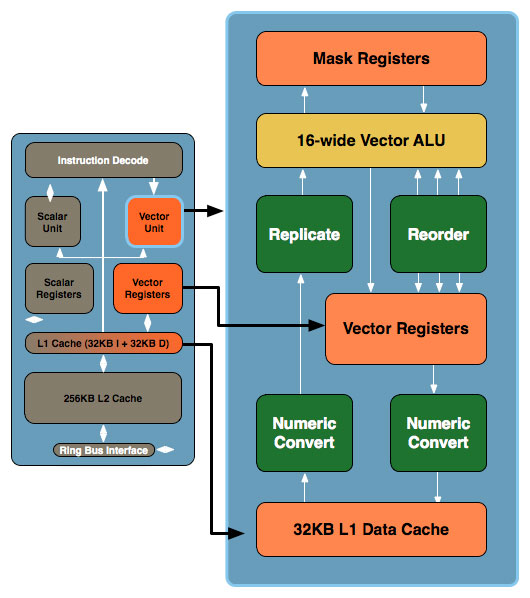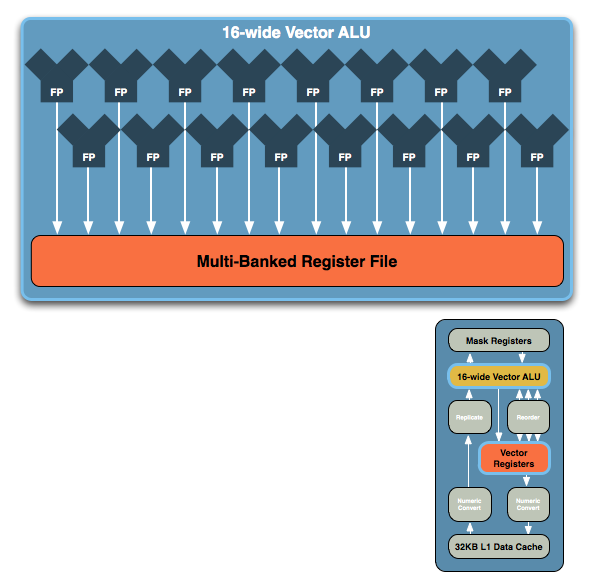Intel's Larrabee Architecture Disclosure: A Calculated First Move
by Anand Lal Shimpi & Derek Wilson on August 4, 2008 12:00 AM EST- Posted in
- GPUs
Drilling Deeper and Making the AMD/NVIDIA Comparison
Don't be fooled by the initial diagram, this simple x86 core gets far more complex. In the image below, the block to the left is the Larrabee core we mentioned earlier, to the right we've blown up the vector unit and its associated parts:

The vector unit is key and within that unit you've got a ton of registers and a very wide vector ALU, which leads us to the fundamental building block of Larrabee. NVIDIA's GT200 is built out of Streaming Processors, AMD's RV770 out of Stream Processing Units and Larrabee's performance comes from these 16-wide vector ALUs:

The vector ALU can behave as a 16-wide single precision ALU or an 8-wide double precision, although that doesn't necessarily translate into equivalent throughput (which Intel would not at this point clarify). Compared to ATI and NVIDIA, here's how Larrabee looks at a basic execution unit level:

NVIDIA's SPs work on a single operation, AMD's can work on five, and Larrabee's vector unit can work on sixteen. NVIDIA has a couple hundred of these SPs in its high end GPUs, AMD has 160 and Intel is expected to have anywhere from 16 - 32 of these cores in Larrabee. If NVIDIA is on the tons-of-simple-hardware end of the spectrum, Intel is on the exact opposite end of the scale.
We've already shown that AMD's architecture requires a lot of help from the compiler to properly schedule and maximize the utilization of its execution resources within one of its 5-wide SPs, with Larrabee the importance of the compiler is tremendous. Luckily for Larrabee, some of the best (if not the best) compilers are made by Intel. If anyone could get away with this sort of an architecture, it's Intel.
At the same time, while we don't have a full understanding of the details yet, we get the idea that Larrabee's vector unit is sort of a chameleon. From the information we have, these vector units could exectue atomic 16-wide ops for a single thread of a running program and can handle register swizzling across all 16 exectution units. This implies something very AMD like and wide. But it also looks like each of the 16 vector execution units, using the mask registers can branch independently (looking very much more like NVIDIA's solution).
We've already seen how AMD and NVIDIA architectural differences show distinct advantages and disadvantages against eachother in different games. If Intel is able to adapt the way the vector unit is used to suit specific situations, they could have something huge on their hands. Again, we don't have enough detail to tell what's going to happen, but things do look very interesting.










101 Comments
View All Comments
ocyl - Monday, August 4, 2008 - link
Larrabee will be shipped when Diablo III is, and it will mark the beginning of the end for DirectX.Calling it first here at AnandTech.
Thanks go to Anand and Derek for the very well written article. You are the ones who keep tech journalism alive.
erikespo - Monday, August 4, 2008 - link
"At 143 mm^2, Intel could fit 10 Larrabee-like cores so let's double that. Now we're at 286mm^2 (still smaller than GT200 and about the size of AMD's RV770) and 20-cores. Double that once more and we've got 40-cores and have a 572mm^2 die, virtually the same size as NVIDIA's GT200 but on a 65nm process. "this math is way off
143 mm^2 is 20449mm.. if they fit 10 there that is 2044.9 per core
286mm^2 is 81796mm.. that is 4X the space so 40 cores in 286^2
and 572mm^2 is 327184mm is 160 cores..
double length will double area.. doubling length and width will quadruple area.
bauerbrazil - Monday, August 4, 2008 - link
Hahahaha, YOUR math is way off!!!Jesus.
erikespo - Monday, August 4, 2008 - link
I see where the article and you got your math..you both did 143mm^2 / 10 and got 14.3 then divided 286^2 by 14.3 and got 20.. this math is only acting on the one number..
I know this because the area of 14.3 is 204.49 mm. 10 of those would be 2044.9mm. but the area of 143mm^2 is 20449mm.
WeaselITB - Monday, August 4, 2008 - link
Wow ... No.143mm^2 is NOT equivalent to 143^2 mm ... Your analysis is flawed.
If we use your example, 2mm^2 is NOT 2mm x 2mm ... it's actually root(2)mm x root(2)mm ... 4mm^2 is 2mm x 2mm, not 4mm x 4mm (that'd be 16mm).
Maybe you should examine in depth that Wikipedia article you linked earlier ...
Thanks,
-Weasel
MamiyaOtaru - Monday, August 4, 2008 - link
143mm^2 is NOT equivalent to 143^2 mm^^THIS
That's it in a nutshell. mm² doesn't mean you square 143, it refers to Square Millimeters, a unit of area (unlike Millimeters, a unit of distance).
Revised mspaint illustration: http://img379.imageshack.us/my.php?image=squaremmh...">http://img379.imageshack.us/my.php?image=squaremmh...
erikespo - Monday, August 4, 2008 - link
Anandtech Comment Section.. Forever record of my retardednesserikespo - Monday, August 4, 2008 - link
Dang.. Many apologies..got my square area and squared numbers confused..
WeaselITB - Monday, August 4, 2008 - link
[quote]4mm^2 is 2mm x 2mm, not 4mm x 4mm (that'd be 16mm).[/quote]Dang, that was supposed to read "(that'd be 16mm^2)."
Thanks,
-Weasel
erikespo - Monday, August 4, 2008 - link
another way to look as it is how man 143mm^2 squares does it take to make up 286mm^2?only 2 would only be 143mm x 286mm
since 10 cores fit into 143 x 143, 20 will fit into 143 x 286mm
286 x 286 (which is double that of 143 x 286mm) the 286mm^2 would fit 40